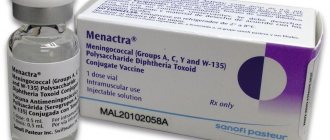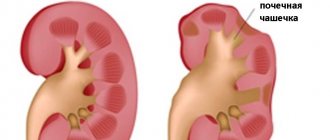Published: 04/16/2012 Updated: 05/20/2021
In the 70s of the last century, a group of infections was identified, the peculiarity of which is that, while relatively harmless for adults and children, they become extremely dangerous for pregnant women. This group of infections is usually called TORCH infections, after the first letters of the Latin names of the infections included in it. This abbreviation stands for: TO - toxoplasmosis; R - rubella (Rubella); C - cytomegalovirus infection (Cytomegalovirus); H - herpes infection (Herpes simplex virus).
The peculiarity of TORCH infections is that when a woman is infected with them during pregnancy, they can have a detrimental effect on all systems and organs of the fetus, especially on its central nervous system, increasing the risk of miscarriage, stillbirth and congenital deformities of the child. Perinatal infections account for approximately 2-3% of all congenital anomalies of the fetus. Most infections are dangerous if they are initially infected during pregnancy. Recurrences of herpes can be dangerous during childbirth and the postpartum period. Often, infection of a pregnant woman with TORCH complex infections is a direct indication for termination of pregnancy.
Let us dwell in more detail on each infection included in the complex.
What are ToRCH infections?
The abbreviation ToRCH comes from the first letters of the most dangerous infections for the fetus - Toxoplasma (toxoplasma infection) - Rubella (rubella) - Cytomegalovirus (cytomegalovirus) - Herpes (herpes). These are classic infections. In addition to them, they also talk about infections such as parvovirus (infection caused by parvovirus B19), listeriosis, hepatitis B and C and some others. All of them can affect people of any gender and age, but the term itself is used in relation to women who are preparing for pregnancy, pregnant women, as well as the fetus and newborn. Rubella, toxoplasmosis, cytomegalovirus and herpes infections are common infections. In most cases, the first encounter with them occurs in childhood and adolescence - this is called primary infection, after which immune protection remains. If the body encounters an infection again, it is called a secondary infection or reinfection.
References
- Order of the Ministry of Health of the Russian Federation dated November 1, 2012 No. 572n “On approval of the Procedure for providing medical care in the field of obstetrics and gynecology (except for the use of assisted reproductive technologies).”
- Infectious diseases: national guidance // Ed. N.D. Yushchuka, Yu.Ya. Vengerova. – M.: GEOTAR-Media, 2010. – 1056 p.
- Sadova N.V. et al. TORCH syndrome: clinical diagnosis and etiological verification // Russian Medical Journal 2014, No. 3 p. 194.
- Nahmias Andre J. The TORCH complex-perinatal infections associated with toxoplasma and rubella, cytomegalo- and herpes simplex viruses. Pediatric Research 5(8):405-406 August 1971.
Why is the examination carried out?
It is before pregnancy (or in the early stages) that we need to find out whether there was an infection or not. If there was, you don’t have to worry, this infection is not dangerous for a pregnant woman. If not, then the doctor will tell you about a set of preventive measures (for example, if we are talking about rubella, then you can get vaccinated, if we are talking about toxoplasma, you can follow certain rules to reduce the risk of infection, etc.). In addition, for those infections for which there are no protective antibodies, it is important to conduct regular monitoring so as not to miss an infection during pregnancy.
Pathogens of IUI
Most bacteria and viruses can be passed on to the unborn baby, causing serious consequences. Those viruses that provoke acute respiratory viral diseases do not reach the fetus. They can be dangerous for the baby only if the pregnant woman has a high temperature.
A mother can become infected with rubella through airborne droplets. It is not necessary to be close to a sick person; infection is also possible at a distance. In this case, the consequence for the fetus will be fetal rubella syndrome.
Cytomegalovirus is transmitted through body fluids. This is mostly saliva, but may include semen and urine, as well as blood. In a child, the infection may manifest itself with corresponding symptoms after birth, or it may occur in a latent form.
Herpes simplex virus 2 is transmitted mainly through unprotected sexual intercourse. If this happens to a pregnant woman, her child will be born with a congenital form of herpes. Parvovirus B19, like rubella, is transmitted by airborne droplets to a pregnant woman. As a result, the fetus develops dropsy and anemia.
Chickenpox is transmitted not only through the air, but also through household contact. A child receives developmental defects due to intrauterine infection (if the infection occurred in the first trimester). If the infection occurs before childbirth, then there will be a congenital form of this disease, and this is a very dangerous condition.
Listeriosis (a bacterial infection) can develop in a pregnant woman if she eats contaminated cheeses, meats or vegetables. The child eventually develops pneumonia and/or sepsis. Syphilis is transmitted to pregnant women through sexual contact if the partner has been infected. After birth, a child develops this disease with all the ensuing consequences. Tuberculosis, which is also a bacterial infection, is transmitted through the air. The embryo can die in the womb, be born prematurely, with a congenital form of tuberculosis.
The essence of the analysis
Blood is taken from a vein of the pregnant woman, which contains antibodies to infections (immunoglobulins Ig). There are five classes of antibodies, but in this case only two should be determined - IgM and IgG. Many laboratories do only a comprehensive examination. But it is quite possible to find out whether the immunoglobulins you are interested in are available, which will cost less. The analysis can reveal not only the presence of antibodies, but also their quantity. The latter option is more preferable, as it gives the doctor maximum information. If necessary, it is possible to find out the time of infection by determining at what point immunoglobulin began to be produced.
Facts about IUI
In less than 10 out of 100 pregnancies, the infection is transmitted to the unborn baby from his mother. And approximately 0.5% of newborns are born with corresponding symptoms. But, if one or another infection is present in the mother’s body, this is not a complete guarantee that the child will also have it.
Some infectious diseases that threaten the development of the embryo are asymptomatic for the mother, without causing much harm to her body. Basically, the fetus becomes infected with the same infection as the mother if she became infected with the disease for the first time.
If a pregnant woman’s disease is detected and treated in time, the risk to the unborn baby is minimal.
Decoding the results
It is important to understand that primary infection with TORCH infections is dangerous during pregnancy. The possibility of getting sick is excluded if the woman has encountered the pathogen before. The results obtained are read as follows: the presence of class G antibodies indicates that the woman has long been ill with an infection, the body has formed immunity that will protect the child and mother from a dangerous disease; class M antibodies indicate an acute infection (primary infection or relapse); the absence of IgM and IgG means that there is a possibility of infection with rubella, toxoplasmosis, herpes and cytomegalovirus. To understand how long ago the infection occurred, it is necessary to analyze the amount of IgG. If these antibodies are not present, it means that the body has encountered the disease recently.
Cytomegalovirus and herpes
TORCH infections do not end only with toxoplasmosis and rubella. It also includes chlamydia and others. And this is C - cytomegalia (cytomegalovirus infection), and H - herpes (herpes virus infection). We can say that all of humanity is infected with them. In any case, statistics show that pregnant women in every fifth case have antibodies to these viruses.
Cytomegalovirus is also transmitted through airborne droplets. While in the case of herpes, in particular genital herpes, primary infection mainly occurs through sexual contact. The herpes simplex virus and its clinical picture are so characteristic that an experienced gynecologist can make a diagnosis even without accompanying examination. That is, the symptoms are:
- bubbles appear;
- itching;
- there may be enlarged lymph nodes;
- possible pain in joints and bones;
- sometimes the temperature rises.
However, tests must be taken to accurately diagnose the disease. And for the study it is necessary to take blood for antibodies and PCR - this is a polymerase chain reaction method, which is also carried out in our “Healer” laboratory in Makhachkala. For this study, the analysis is taken directly from this vesicle or from another lesion that reminds us of herpes.
I repeat once again that it is good to be tested for this infection before conception. But even during pregnancy, given that there may be reactivation of this virus or the so-called recurrent course of the virus, we must carefully monitor the titer of antibodies to herpes. If the titer of immunoglobulin G antibodies tends to increase and in the patient, despite the fact that we have not detected M, the value of immunoglobulin G increases, then we usually carry out direct antiviral therapy.
Well-known drugs such as Acyclovir and Zovirax, known to everyone, are prescribed, which do not affect the fetus and can be successfully used during pregnancy. But, if this is a recurrent course of herpes, then there is no need to prescribe medications throughout pregnancy. It is necessary to do this closer to childbirth. So that the fetus during physiological childbirth does not become infected while passing through the birth canal if an exacerbation suddenly occurs. That is, the exacerbation of herpes seems to be stopped.
If you have acute herpes, which has not been cured, and you go into labor with this, then of course only a caesarean section is necessary. Because there is a high risk of infection for the child during the passage of the birth canal. If a child becomes infected during childbirth and in the early neonatal period, many different complications can arise.
General recommendations
If a woman does not have antibodies to rubella, it is advisable to get vaccinated. In this case, pregnancy is possible only three months after vaccination. It is not possible to protect yourself from other infections in this way. If an acute disease is detected, it is necessary to first be cured, and only then conceive a child. A pregnant woman without immunity to TORCH infections needs to be very attentive to her health and avoid visiting places of possible infection. Limiting contact with cats, being careful when working with raw meat, and planting flowers and beds in the ground will protect you from toxoplasmosis. Be sure to wash your hands thoroughly after such contact. The presence of high titers of class M immunoglobulin requires immediate consultation with a doctor to prescribe more in-depth studies and treatment to avoid problems with fetal development.
Prevention of diseases of the TORCH complex
First of all, take care of your immunity. And for this it is very important to lead a healthy lifestyle, move more, maintain a proper diet, avoid stressful situations and do not forget about rest, preferably spending more time in nature. Also, women planning a pregnancy need to undergo monthly tests in order to promptly detect primary infection and take effective measures to prevent infection of the fetus.
You can protect yourself from infection with toxoplasmosis by avoiding contact with pets. Vegetables, fruits and meat products must be thermally treated before consumption. Remember to wash your hands thoroughly before eating. Vaccination, which should be done before pregnancy, can help prevent rubella infection. To prevent cytomegalovirus, it is necessary to avoid contact with sick people, and to protect against genital herpes, it is important to protect yourself from unprotected sex with infected partners.
Tests for TORCH infections can be taken at our medical office.
In conclusion, I want to say what you have been told for the past few years: “Wash your hands, maintain hygiene and be healthy!”
Kallaeva Aida Khairutdinovna, gynecologist, colposcopist, juvenile specialist at the “Healer” medical clinic in Makhachkala, candidate of medical sciences, doctor of the highest category.
Consequences of intrauterine infection
Congenital infection can be acute or chronic. Consequences of acute infection:
- shock
- pneumonia
- severe sepsis
Symptoms of acute intrauterine infection in newborns:
- activity decreasing every day
- long sleep
- poor nutrition
But in most cases there are no symptoms. Long-term consequences of IUI:
- delayed motor development
- mental problems
- visual impairment
- partial or complete deafness
If the infection has penetrated the uterus, the consequences may be:
- stillbirth
- antenatal embryo death
- frozen pregnancy
- miscarriage
If the fetus survives, it will have the following manifestations of IUI:
- Fever
- Skin rashes
- Hydrops fetalis
- Anemia
- Jaundice and enlarged liver
- Pneumonia
- Myocarditis
- Chorioretinitis, cataract
- Micro- and hydrocephalus
Intrauterine infection is dangerous regardless of gestational age. But some pathogens are most dangerous in the first 3 months. A striking example is the rubella virus. Very serious consequences will occur if the mother is infected with chickenpox in the very last week of pregnancy. The consequences can be very different. You can find out about them from your doctor based on the results of ultrasound, tests, gestational age and the detected causative agent of the disease. This means that each case is individual in terms of the course of the disease and in terms of consequences.
Risk groups for intrauterine infection
Women who:
- live in a family with children who go to kindergarten, school, or other institutions
- work in the medical field, having contact with carriers of diseases or sick people
- work in preschool and school children's institutions
- have 2 or more medical abortions
- patients with inflammatory pathologies that occur in a chronic form
- have untimely rupture of amniotic fluid
- have a history of embryonic malformations and antenatal fetal death
- have once given birth to an infected child (one or more)
Anti-Toxo-IgG (IgG class antibodies to Toxoplasma gondii)
Class G antibodies to Toxoplasma gondii (T. gondii).
Antibodies class G
are produced for the toxoplasma antigen in acute, subacute, chronic and latent forms of toxoplasmosis after 3 - 4 weeks from the moment of infection. Class G antibodies usually persist for life. They perform a protective function and prevent re-infection in the vast majority of cases.
Features of infection.
The causative agent, Toxoplasma gondii, is a protozoan. The life cycle of the pathogen takes place inside the cells of the host organism. The definitive host of the parasite, infected cats and other representatives of the feline family, excrete a special form of toxoplasma - oocysts - in their feces. Oocysts are stable in the external environment. Oocysts that enter the body of an intermediate host (rodents, birds, livestock, humans) continue their life cycle in the muscle and other tissues of the body, where pseudo- and true cysts are formed.
Anti-Rubella-IgG (IgG antibodies to the rubella virus)
An indicator of the presence of immunity to the rubella virus.
IgG antibodies to the rubella virus begin to be produced 3-4 weeks after infection and are detected after the end of the acute illness for life, providing protection against re-infection. Detection of anti-Rubella-IgG in a concentration of less than 10 U/ml indicates their insufficient level to protect against clinical manifestations of the disease with or without exposure to the rubella virus.
An anti-Rubella-IgG level of more than 10 U/ml is recommended as an indicator of the presence of immunity to this virus. Determination of anti-Rubella-IgG titers over time (in paired studies with an interval of 2-3 weeks) is used, if necessary, to confirm a recent infection with the rubella virus (in addition to the determination of anti-Rubella-IgM). A significant increase in IgG titers indicates the severity of the process. Positive anti-Rubella IgG results when testing umbilical cord blood or newborn blood should be interpreted with caution, since specific IgG can be transmitted to the fetus from the mother through the placenta.
Content
This profile includes the following tests:
- Anti-Toxo-IgG (IgG class antibodies to Toxoplasma gondii).
- Anti-Toxo-IgM (IgM class antibodies to Toxoplasma gondii).
- Anti-CMV-IgG (IgG class antibodies to cytomegalovirus, CMV).
- Anti-CMV-IgM (IgM antibodies to cytomegalovirus, CMV).
- Anti-Rubella-IgG (IgG antibodies to the rubella virus).
- Anti-Rubella-IgM (IgM antibodies to the rubella virus).
- Anti-HSV-IgG (IgG class antibodies to herpes simplex virus types 1 and 2).
- Anti-HSV-IgM (IgM class antibodies to herpes simplex virus types 1 and 2).







